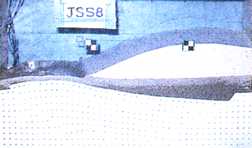| enginuity |
|
Research at the Centrifuge Centre
The Geotechnical Centrifuge Centre at the High Cross site, West Cambridge, currently houses four centrifuges. 'We use small-scale models to replicate full-scale prototypes,' explains Dr Sarah Springman of the Soil Mechanics group. 'By varying the model parameters we can observe important modes of behaviour and carry out a number of trials within the same budget as would be required for one full-scale test'. The sophisticated instrumentation associated with the centrifuges gives the freedom to investigate mechanisms of failure as well as the mechanisms of deformation before failure. Finite element analysis is used both for prediction and for back analysis.

10-metre beam centrifuge built by CUED and In operation for 20 years.
There are three or four main thrusts to the work carried out by the team. Dr Chrysanthi Savvidou works on pollution migration which comes under the banner of 'environmental engineering' - For instance, in the case of a polluted landfill, the rate of spread of the plume of pollution can be observed, and strategies for dispersal or clean-up can be investigated. Using a small model in a centrifuge, the diffusion occurring in 27 years can be simulated in one day.
The Centre was the brainchild of Professor Andrew Schofield, who heads the team. His group has close relations with the UK Transport Research Laboratory, Canadian Cold Regions Laboratory, US Army Corps of Engineers Waterways Experimental Station, oil companies such as Exxon and Shell, many Japanese construction companies, and dozens of other centrifuge centres around the world.
Dr Gopal Madabhushi, a Research Fellow, is working on the modelling of seismic interactions such as the response of tower structures and the stability of saturated slopes of varying steepness during earthquakes.
Dr Malcolm Bolton and Dr Sarah Springman work together on the influence of soil movements on structures. For example, a detailed observation of the movements of model bridge abutments has led to more accurate design of piled foundations, and recommendations that piles can be omitted (with great cost saving) in many cases. Similar investigations have included the use of polymer grids or geotextiles to reinforce embankments built on soft clay, in order to steepen sides and reduce land acquisition costs. This work has been funded mainly by the Transport Research Lab, with support from the European Community.

Model embankment on soft ground falls during construction.
Work on compensation-grouting during tunnel construction has important implications for historic buildings in London, for instance, where the tunnelling of new underground lines would cause damaging differential settlements in the buildings above. By pumping grout into the ground above the line of the advancing tunnel face, the emergence of a settlement trough at the ground surface can be avoided.
Please contact Dr Malcolm Bolton on (01223) 332716 for more information.
| number 2, spring '94 |